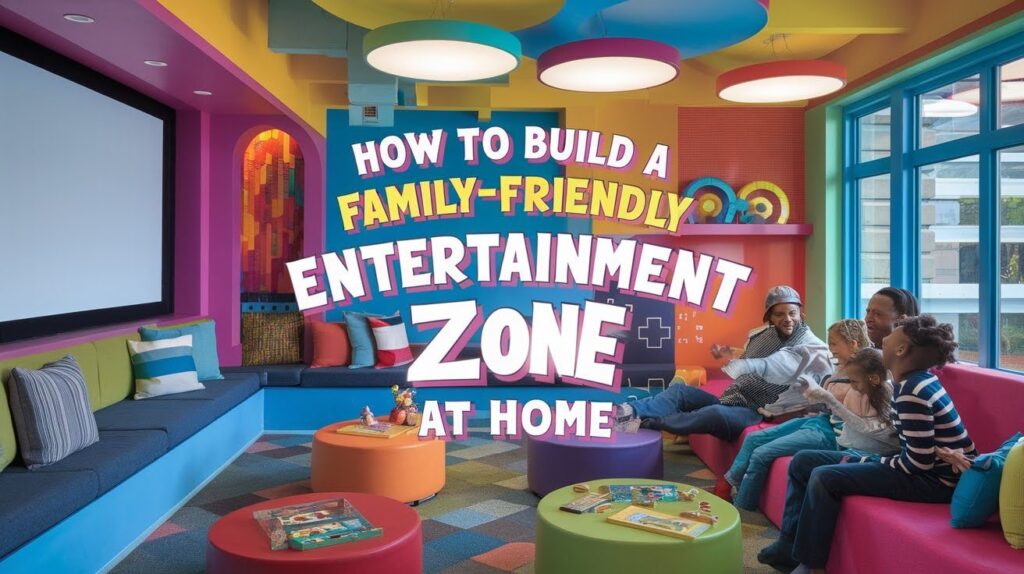Creating a family entertainment zone that works for everyone feels impossible. I know because I spent months trying different setups that failed.
This guide will solve that problem.
You’ll learn how to plan your space, choose the right furniture, and create areas for every age group. I’ll show you budget-friendly DIY ideas and safety tips that actually work.
I’ve helped dozens of families build their spaces over the past five years. My approach works because I’ve tested every tip with real families.
You want a space where your whole family gathers naturally. This article gives you that exact plan.
Let’s build something amazing together.
Why Your Family Needs an Entertainment Zone
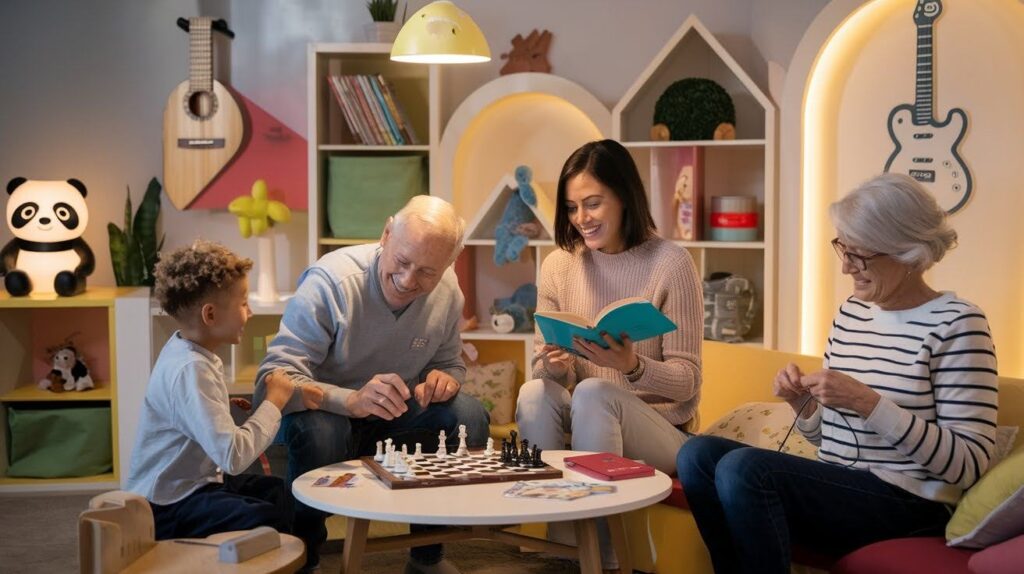
Creating a dedicated fun space changed everything in my house. Here’s what happened:
More family time together. Instead of everyone scattered in different rooms, we started gathering in one spot.
Less screen time battles. When you have engaging activities ready, kids naturally choose them over constant scrolling.
Happier relationships. Shared fun creates bonds that last way beyond game night.
Your home becomes the hangout spot. Other families started asking to come over instead of going out.
The best part? You don’t need a mansion or huge budget to make this work.
Planning Your Entertainment Zone
Before you buy anything, take a good look around your home.
Pick the right room. I chose our basement, but you might use a living room corner, spare bedroom, or even a garage.
What matters most:
- Easy access for everyone
- Good lighting (add more if needed)
- Enough space to move around
- Away from quiet study areas
Measure everything twice. Trust me on this one. I learned the hard way when my new couch wouldn’t fit through the door.
Think about traffic flow. People need clear paths to walk without bumping into furniture or stepping on games.
Choosing the Right Equipment and Furniture
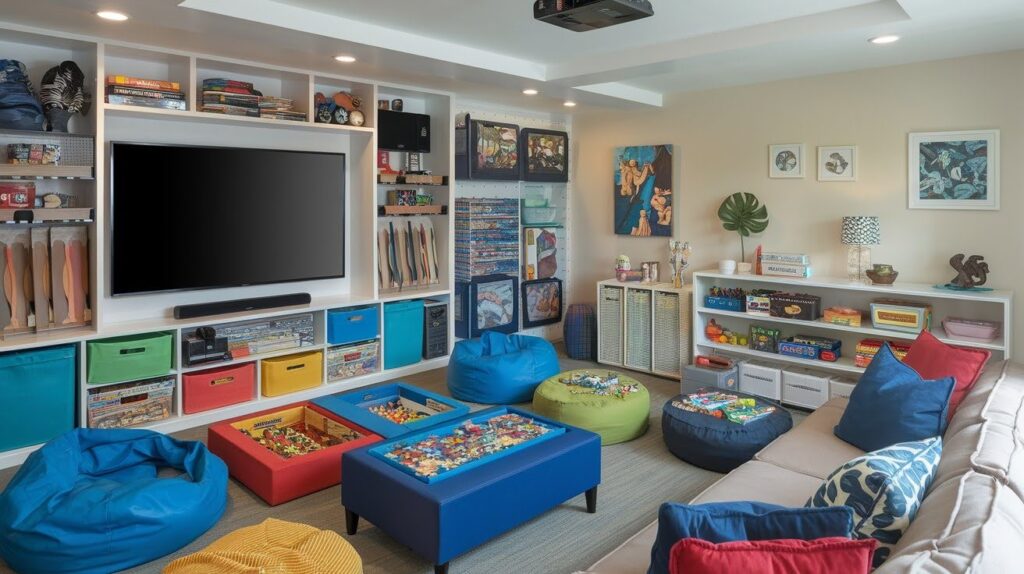
This is where the magic happens. Let me break down what actually works.
Entertainment Essentials
Start with one good TV or projector. You don’t need the fanciest model, just something everyone can see clearly.
Gaming consoles work great, but don’t forget about:
- Board games (stored in easy-reach bins)
- Card games
- Puzzles for rainy days
- Bluetooth speakers for music
Here’s a secret: Rotate your games monthly. Kids think they got new stuff without you spending more money.
Comfortable Seating
Forget matching furniture sets. Mix different types of seating instead.
I use:
- One big sectional couch
- Bean bags for kids
- Floor cushions that stack away
- A couple of recliners for adults
Choose dark colors or patterns. They hide spills and wear better than light fabrics.
Multipurpose Furniture
Storage ottomans became my best friend. Here’s what works:
- Hold games inside and work as extra seats during parties
- Double as footrests for movie nights
- Move easily around the room when needed
Coffee tables with shelves underneath keep controllers and remotes organized. No more hunting for the TV remote under couch cushions.
Folding tables are lifesavers. Set them up for board games, then fold them away when you need dance space.
Kid-Safe Options
Round table corners save shins and heads. Here are my top safety picks:
- Foam-filled cushions instead of springs for soft landings
- Cord protectors from the hardware store for electrical safety
- High storage for small game pieces away from toddlers
- Non-slip mats under rugs to prevent sliding
Theme and Decor Ideas
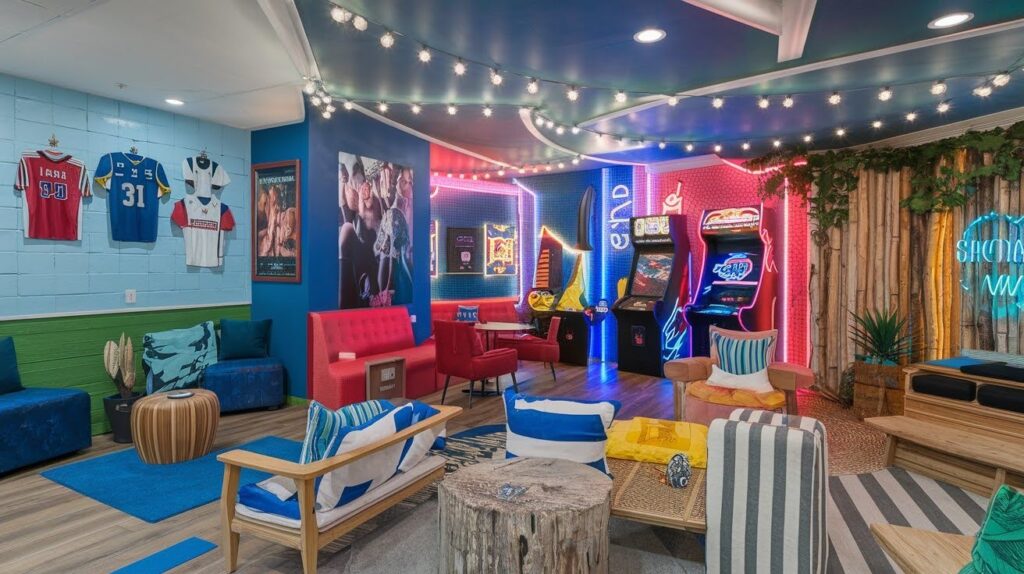
You might think theming is complicated, but it’s actually fun and simple.
Sports theme: Team jerseys on walls, sports equipment as decoration, team colors for pillows and rugs.
Movie theater vibe: Dark walls, string lights, vintage movie posters, popcorn machine if your budget allows.
Game room classic: Neon signs, arcade-style artwork, bright colors that pop.
Nature theme: Forest greens, camping gear as decor, outdoor photos.
Pick one theme and stick with it. Too many themes make spaces feel chaotic instead of cozy.
Fun Zones for All Ages
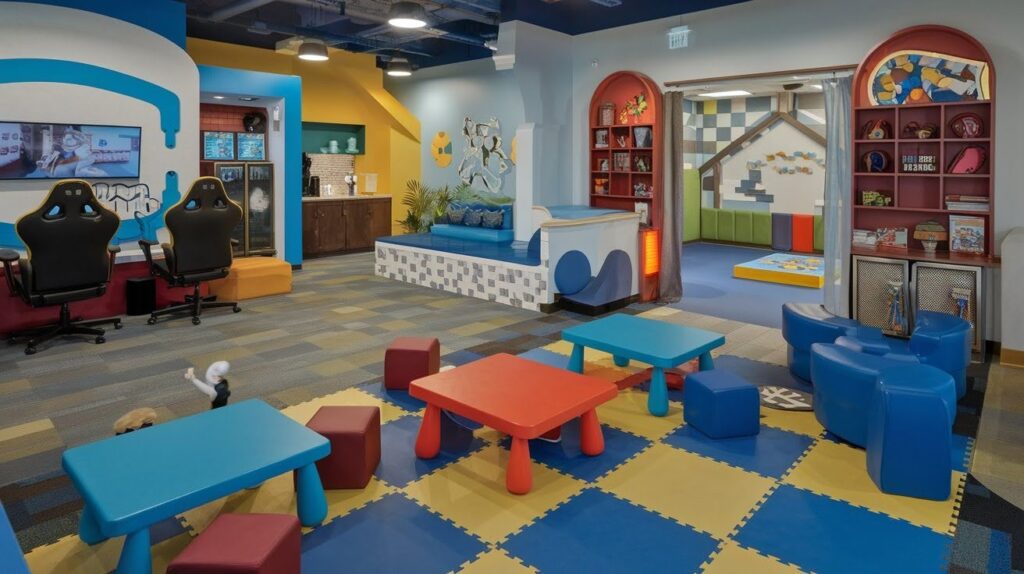
Here’s where you create something special for everyone.
Kids’ Corner
Set up one area just for the little ones. I used colorful foam tiles for flooring because they’re soft and easy to clean.
Low storage bins let kids grab their own toys and games. Label everything with pictures so non-readers can find stuff too.
Add a small table and chairs sized for kids. They love having their own space that fits them perfectly.
Teen Hangout
Teens need different energy. Gaming chairs that feel “cool” work great here.
A mini-fridge keeps snacks and drinks handy if your budget allows. Good lighting helps with selfies and homework.
Charging stations for all their devices prevent arguments about phone batteries. Let them help decorate this section. When teens feel ownership, they actually use the space more.
Adult Relaxation Spot
Don’t forget about yourself!
I claimed one corner with a really comfortable chair. Good reading light makes this spot perfect for morning coffee or late evening wind-down time.
A small side table for coffee cups works perfectly. Add a throw blanket for movie nights when you want to get cozy.
Multi-Use Family Activities
The center area should work for everyone together.
Large coffee table for board games that need space. Make sure it’s the right height for kids and adults to use comfortably.
Keep an open floor area for active games like charades or dance contests. Flexible seating moves easily when you need more room for activities.
Slotting Solitaire as a Solo Game Option
Sometimes family members want quiet alone time in the shared space.Solitaire games work perfectly for this.
Set up a small side table with a deck of cards. It gives people a peaceful activity that doesn’t need screens or noise.
I keep several different solitaire game instruction cards in the drawer. Spider, Klondike, and FreeCell are favorites.
Digital solitaire works too-you can even play casino Solitaire if you prefer an online version-but actual cards feel more relaxing. Plus, other people can join in if they want.
Budget-Friendly DIY Ideas

You don’t need expensive things to create a great space.
DIY storage: Use old dresser drawers as under-table storage boxes. Paint them fun colors.
Homemade game tables: Plywood on folding legs makes perfectly good game surfaces. Cover with fabric for a finished look.
Wall art: Frame your family’s artwork or photos from fun times together. Way more personal than store-bought prints.
Lighting: String lights create great mood lighting for almost nothing.
Seating: Large floor pillows cost less than furniture and work great for kids.
Safety and Practical Tips
- Safety doesn’t have to kill the fun vibe.
- Secure heavy furniture to walls, especially if you have climbers in the family.
- Non-slip rugs prevent sliding around during active games.
- Keep a small first aid kit nearby, but don’t make it obvious. Tuck it in a drawer or cabinet.
- Good ventilation matters more than you think. Lots of people in one space gets stuffy fast.
Maintenance and Longevity
- Creating the space is just the beginning. Keeping it great takes some planning.
- Weekly pickup routine prevents total chaos. Make it a family activity with music playing.
- Monthly deep clean keeps everything fresh. Vacuum furniture, wipe down surfaces, organize game storage.
- Quarterly rotation of games and activities keeps things interesting. Store some stuff and bring out others.
- Teach everyone to clean up after themselves. This isn’t mean, it’s practical.
Conclusion
I’ve shared everything that worked for my family and dozens of others. You now have the complete plan.
Building your entertainment zone doesn’t happen overnight. Start with one small area this weekend. Pick your furniture or choose a theme.
The magic happens when you take action.
Your kids will remember family game nights forever. They’ll forget about expensive gadgets, but never the fun you created together.
Don’t wait for the perfect moment or bigger budget. Start today with what you have.
Which section will you tackle first? Planning your layout or setting up that kids’ corner? Drop a comment below and tell me your first step. I’d love to help you succeed.
Frequently Asked Questions
How much space do I need for a family entertainment zone?
You don’t need a huge room to create something great. Even a 10×10 corner of your living room works perfectly fine. The key is smart furniture choices and good organization.
What’s the minimum budget to get started?
You can start with just $200 for basic seating and storage bins. I’ve helped families create great spaces using mostly DIY solutions and secondhand finds. Focus on one area at a time instead of buying everything at once.
How do I keep the space organized with kids around?
Make cleanup part of the fun routine with a 5-minute pickup game each night. Use labeled storage bins at kid height so they can put things away themselves. Simple systems work better than complicated organization methods.
Can I create different zones in one small room?
Yes, and it’s actually easier than you think. Use furniture placement to define areas naturally. A bookshelf can separate the kids’ corner from the teen hangout without walls or expensive dividers.
What safety features matter most for mixed age groups?
Secure heavy furniture to walls and choose rounded table corners over sharp edges. Keep small game pieces stored up high away from toddlers. Good lighting prevents trips and falls during active games.

